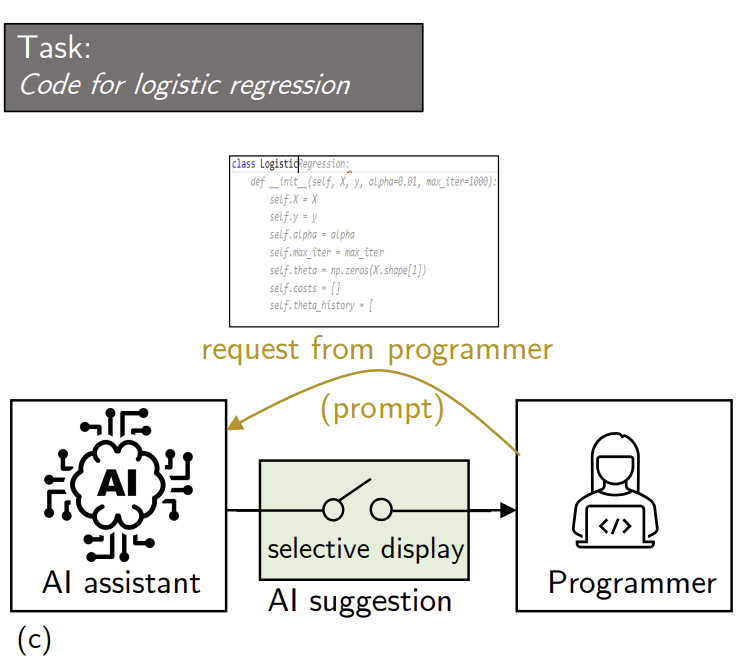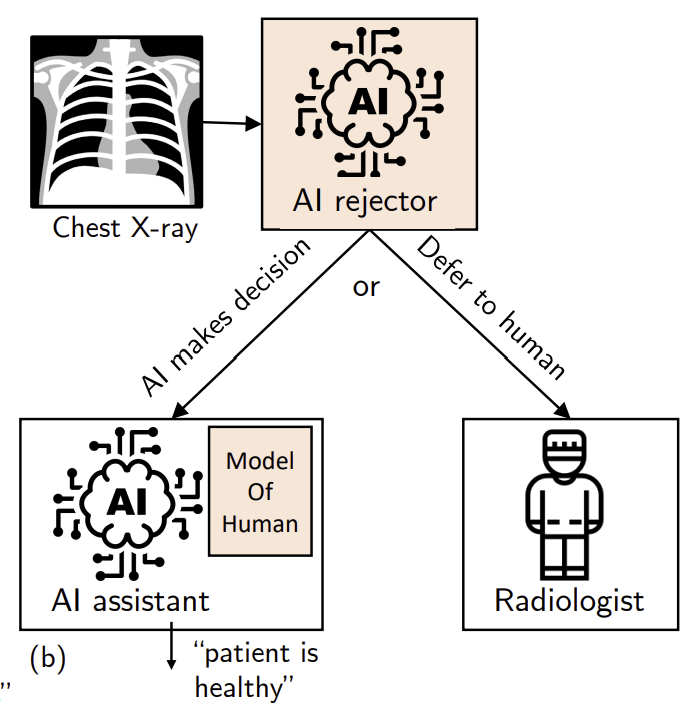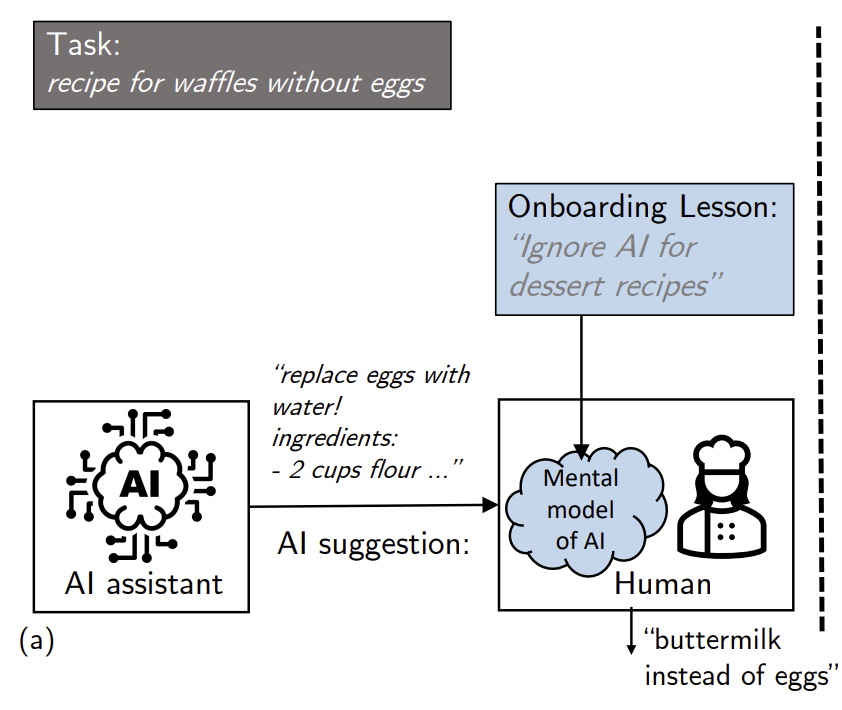Hussein Mozannar
Senior Researcher at Microsoft Research AI Frontiers
I am a Senior Researcher at Microsoft Research AI Frontiers working in the Human-AI experiences team . I obtained my PhD from MIT in Social & Engineering Systems and Statistics in 2024 and my undergraduate degree in computer engineering from the American University of Beirut in 2019.
My research focuses on augmenting humans with AI to help them complete tasks more efficiently. Specifically, I focus on building AI models that complement human expertise and designing interaction schemes to facilitate human-AI interaction. The main applications of my research have been software development, web navigation and healthcare.
Currently, I am working on AI agents that can perform actions on the browser to help people in their daily tasks.
You can reach me at hmozannar@microsoft.com
Research
AI-Assisted Programming
 AI has changed the way we write code for a lot of us. LLMs have been adopted by millions of programmers to help them write their code. The forms of AI-assisted programming are diverse, ranging from code completions (original GitHub Copilot), chat-based general-purpose AI assistants (ChatGPT), and newer forms that integrate AI agents and code edits. The goal of my research is to understand how people interact with these AI systems, how we can evaluate their impact on programmers' performance, and how we can design new interfaces that integrate AI.
AI has changed the way we write code for a lot of us. LLMs have been adopted by millions of programmers to help them write their code. The forms of AI-assisted programming are diverse, ranging from code completions (original GitHub Copilot), chat-based general-purpose AI assistants (ChatGPT), and newer forms that integrate AI agents and code edits. The goal of my research is to understand how people interact with these AI systems, how we can evaluate their impact on programmers' performance, and how we can design new interfaces that integrate AI.My previous work includes:
- Reading between the lines: Modeling user behavior and costs in AI-assisted programming [CHI 2024] - profiles how people interact with code autocomplete systems and introduces a taxonomy of interactions (CUPS).
- When to show a suggestion? Integrating human feedback in AI-assisted programming [AAAI 2024] - introduces a mechanism (CDHF) for when to display AI code suggestions based on human feedback
- The RealHumanEval: Evaluating Large Language Models' Abilities to Support Programmers - proposes a human evaluation method to assess how different AI models (GPT-3.5, CodeLlama,...) improve programmer productivity.
- Need Help? Designing Proactive AI Assistants for Programming - introduces a proactive chat-based AI assistant that also integrates chat suggestions into the code.
- Simulating Iterative Human-AI Interaction in Programming with LLMs - proposes a simulation environment for evaluating AI-assisted programming interfaces
Learning to Defer to Humans
 How do we combine AI systems and human decision-makers to both reduce error and alleviate the burden on the human? AI systems are starting to be frequently used in combination with human decision-makers, including in high-stakes settings like healthcare and content moderation. A possible way to combine the human and the AI is to learn a 'rejector' that queries either the human or the AI to predict on each input. This allows us to route examples to the AI model, where it outperforms the human, so as to simultaneously reduce error and human effort. Moreover, this formulation allows us to jointly optimize the AI so as to complement the human’s weaknesses, and to optimize the rejector to allow the AI to defer when it is unable to predict well. This problem is referred to as the 'learning to defer' problem.
How do we combine AI systems and human decision-makers to both reduce error and alleviate the burden on the human? AI systems are starting to be frequently used in combination with human decision-makers, including in high-stakes settings like healthcare and content moderation. A possible way to combine the human and the AI is to learn a 'rejector' that queries either the human or the AI to predict on each input. This allows us to route examples to the AI model, where it outperforms the human, so as to simultaneously reduce error and human effort. Moreover, this formulation allows us to jointly optimize the AI so as to complement the human’s weaknesses, and to optimize the rejector to allow the AI to defer when it is unable to predict well. This problem is referred to as the 'learning to defer' problem.My previous work includes:
- Consistent estimators for learning to defer to an expert [ICML 2020] - introduces a consistent estimator for learning to defer.
- Sample efficient learning of predictors that complement humans [ICML 2022] - proves the theoretical benefits of learning to defer and introduces active learning algorithms
- Who Should Predict? Exact Algorithms For Learning to Defer to Humans [AISTATS 2023] - introduces an improved estimator for learning to defer and an evaluation framework.
Teaching Humans How to Interact with AI
 A key question is how does the human expert know when to rely on the AI for advice. The literature on human-AI collaboration has often revealed that humans often underperform expectations when working with AI systems. The negative results of human-AI performance may be attributed to a few possible reasons. First, humans can have miscalibrated expectations about AI’s ability, which leads to over-reliance. Second, the cost of verifying the AI’s answer with explanations might be too high thus providing a bad cost-benefit tradeoff for the human and leading to either over-reliance or under-reliance on the AI. Finally, the AI explanations do not enable the human to verify the correctness of the AI’s answer and thus are not as useful for human-AI collaboration.
A key question is how does the human expert know when to rely on the AI for advice. The literature on human-AI collaboration has often revealed that humans often underperform expectations when working with AI systems. The negative results of human-AI performance may be attributed to a few possible reasons. First, humans can have miscalibrated expectations about AI’s ability, which leads to over-reliance. Second, the cost of verifying the AI’s answer with explanations might be too high thus providing a bad cost-benefit tradeoff for the human and leading to either over-reliance or under-reliance on the AI. Finally, the AI explanations do not enable the human to verify the correctness of the AI’s answer and thus are not as useful for human-AI collaboration.We make the case for the need to initially onboard the human decision-maker on when and when not to rely on the automated agent. We propose that before an AI agent is deployed to assist a human decision-maker, the human is taught through a tailored onboarding phase how to make decisions with the help of the AI. The purpose of the onboarding is to help the human understand when to trust the AI and how the AI can complement their abilities.
My previous work includes:
- Teaching humans when to defer to a classifier via exemplars [AAAI 2022]
- Effective human-AI teams via learned natural language rules and onboarding [NeurIPS 2023]
You can find my full list of publications on my Google Scholar